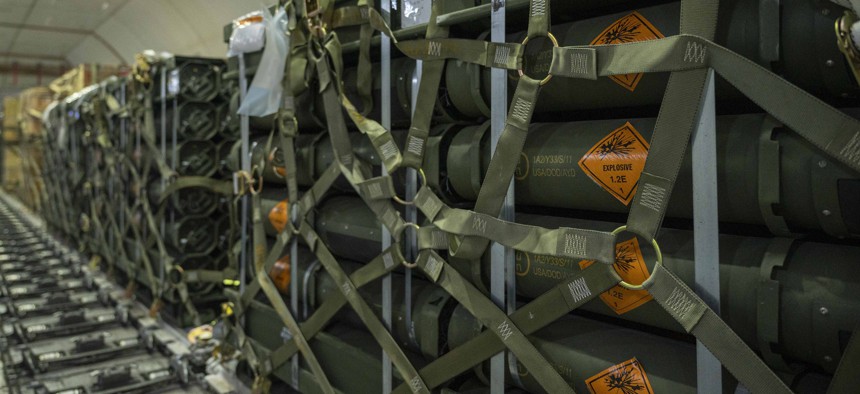
Pallets of ammunition bound for Ukraine from Dover Air Force Base, Delaware, Jan. 13, 2023. U.S. Air Force / Airman 1st Class Amanda Jett
EU plans to arm Ukraine bearing fruit, but more is needed, Estonia says
Ahead of a US visit, top defense ministry leader says effort to deliver a million artillery shells will likely reach its goal by next summer.
TALLINN—As Russia’s invasion of Ukraine grinds through its second year, Estonia’s top Defense Ministry civil servant sees a simple solution for ending the war: more ammunition.
“We need to make it happen faster than the Russians, more effectively than the Russians,” said Kusti Salm, permanent secretary at the Estonian Ministry of Defense, in an interview with Defense One at Estonia’s Defense Ministry. “And then Ukraine will win the war. This is relatively simple.”
Making that happen is another story. While Salm sees signs of hope that the EU can provide the right signals to arms manufacturers, he noted relatively low increases in defense budgets and a lack of broader EU legal reforms that would encourage more arms production.
Ammunition has defined the war in Ukraine, with Ukrainian forces firing up to 240,000 shells per month and Russian units last year estimated to fire as much as 600,000 shells per month.
While the United States and Europe have donated over a million shells from their own stockpiles, their production of new shells is far below Ukraine’s consumption. U.S. plants are turning out fewer than 24,000 of its most common 155mm shells per month, while total EU capacity is about 300,000 yearly.
These shells are also far more expensive than comparable Russian ammunition. For every European 155mm shell produced at a cost of $5,000 to $6,000, the Russians can manufacture a good-enough shell for around $600, Salm said.
In March 2022, the EU announced a Estonian-led initiative that sees the EU spending two billion euros to acquire the shells for Ukraine over a year. The money is being spent to support new joint procurement and to replace shells that can be sent directly from stockpiles.
Salm said the plan will likely fall short of its 12-month delivery goal, but was confident that the shells would be delivered by mid-2024.
Despite the slightly delayed timeline, Salm sees the progress as a major success for the European defense sector, which he has previously said moved too slowly to adapt to Russia’s invasion.
“It goes against all the theories that, ‘well, it cannot be done, because we cannot hire people and the capital is too expensive’,” he said. “If we harness our political will, then change can happen”
Most of the rounds will come from European manufacturers, Salm said. That appears to resolve a heated question of whether to buy from EU plants or third-party sources.
Another potential source may be refurbished 155mm shells held in storage, Salm said, saying the topic had been brought up at a recent meeting of EU defense ministers in Spain.
Salm said more third-party shells may be included in future tranches if there are shortfalls in European output.
Despite the progress made on shells, he cautioned that Europe has not yet sufficiently revved up its defense industrial base.
Although ammunition and arms production is “the ultimate guarantee” of Ukrainian victory, neither U.S. nor European defense budgets have risen since the war in real terms, Salm noted.
Last year, Western and Central European defense budgets averaged a 3.6 percent increase in real terms over the previous year, according to research institute SIPRI, with the U.S. clocking a 0.7 percent increase in real terms for the same period. Russia, meanwhile, saw a 9.6 percent increase in spending in real terms.
Salm believes the European Union has the levers it needs to prompt an increase in defense spending, even though when it comes to stimulating production, the EU has “a track record in basically every sector except defense for the last 50 years,” he said.
The current European defense manufacturing climate favors production of highly accurate but expensive weapons that guarantee higher margins than the production of more basic goods like artillery shells, Salm said.
Many manufacturers also further seek to improve their economic position by making equipment that is not interoperable, Salm added. One story in the Kyiv Independant noted Ukrainian soldiers had to saw down the fins of 120mm shells for their 120mm mortars, as the French-supplied ammunition would not fit in their Italian-supplied tubes.
Business cases are “more geared towards sustainment and spare parts,” said Salm.
By contrast, “I think what the Ukrainian war has also taught every one of us is that good enough is good enough,” he said. “The only ammunition that’s good is the ammunition that you have when you need it. Not what you have in your work order books in three years.”
European leaders also already understand the necessity of getting ammunition production on track, said Salm. “The acknowledgement in the West strategically between all the prime ministers and presidents is that Ukraine needs to win the war.”
Making the political choice to act on this, though, is another matter, particularly for those countries for whom Russia is a distant neighbor. Salm says such European leaders should be persuaded by making an economic case for Ukrainian victory.
“Our message needs to be much more refined. Investing into defense cannot only be a threat perception story, it also needs to be a story of competitiveness, jobs, innovation, growth experts, new factories,” he said. “That generates political support.”
The alternative is a Russian victory — and the potential for a future war where the Russians have learned from their mistakes in Ukraine. “It will be much bloodier,” Salm said.




